Hartlepool - Picture
More about World War 1
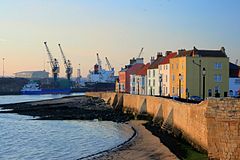
|
|
Hartlepool
Hartlepool

Picture - Hartlepool - Hartlepool shown within County Durham
Population: 90,290 (2006)
OS grid reference: NZ508331
- London: 416km
Unitary authority: Hartlepool
Ceremonial county: County Durham
Region: North East
Country: England
Sovereign state: United Kingdom
Post town: HARTLEPOOL
Postcode district: TS24 - TS27
Dialling code: 01429
Police: Cleveland
Fire: Cleveland
Ambulance: North East
EU Parliament: North East England
UK Parliament: Hartlepool
: List of places: UK, England, County Durham
Coordinates: 54°41â²N 1°13â²W / 54.69°N 1.21°W / 54.69; -1.21
Hartlepool ( /ËhÉËtlɪpuËl/) is a town and port in North East England.
It was founded in the 7th century AD, around the Northumbrian monastery of Hartlepool Abbey. The village grew during the Middle Ages and developed a harbour which served as the official port of the County palatine of Durham. A railway link from the north was established from the South Durham coal fields to the historic town. An additional link from the south, in 1835, together with a new port, resulted in further expansion, with the establishing of the new town of West Hartlepool. Industrialisation and the establishing of a shipbuilding industry during the later part of the 19th century caused Hartlepool to be a target for the German Navy at the beginning of the First World War. A bombardment of 1150 shells on 16 December 1914 resulted in the death of 117 people. A severe decline in heavy industries and shipbuilding following the Second World War caused periods of high unemployment until the 1990s when major investment projects and the redevelopment of the docks area into a marina have seen a rise in the town's prospects.
Hartlepool is within the unitary authority area of the Borough of Hartlepool, for ceremonial purposes part of County Durham; it was a major component of the short-lived County of Cleveland.
Origins of name
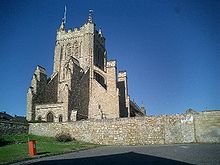
Picture - St. Hilda's Church on Hartlepool Headland, built by the Normans and for centuries known as the Jewel of Herterpol.
The place name derives from Old English *heort-ieg "hart island", referring to stags seen, and pol, "pool". Records of the place-name from early sources confirm this:
649: Heretu, or Hereteu
1017: Herterpol, or Hertelpolle
1182: Hierdepol
Hart is the Old English name for a stag or deer which appears on the towns crest and le pool meant by the sea, people moved here to hunt where there were deer by the sea and eventually settled there. The petrified forest below the sea provides proof that hart (deer) did once live in a forest by the sea.
Geography
Nearby towns and cities include: Billingham (8 miles): Darlington (25); Durham (17); Middlesbrough (12); Newcastle upon Tyne (30); Peterlee (8); Seaham (17); Sedgefield (13); Stockton-on-Tees (10) and Sunderland (21). The monument at Eston Nab can be seen, beyond the far side of the Tees Bay, to the south.
History
Early history
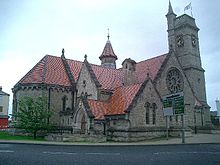
Picture - Christ Church was built from materials excavated to build the new docks during the industrial revolution, and intended to satisfy the spiritual needs of the new workforce. It is now Hartlepool's art gallery and visitor centre.
After the Romans left England, the east coast began to be raided by Norsk men. They then settled in the area, creating what is today Northumbria. Hartlepool began as a Saxon settlement, but was founded as a village in the 7th century AD, springing up around Hartlepool Abbey, founded in 640 on a headland overlooking a natural harbour. Founded by St Aidan, the monastery became famous under St Hilda, who served as its abbess from 649-657. But it fell into decline and was probably destroyed by the Vikings in 800.
After Norman conquest of 1066, the De Brus family gained ownership of the lands surrounding Hartlepool. William the Conqueror built Durham Castle and brought stability to the area, and the villages were first mentioned in records in 1153 when Robert de Brus, 1st Lord of Annandale became Lord of Hartness. The town's first charter was received before 1185, for which it gained its first mayor, an annual two-week fair and a weekly market.
By the time of the Middle Ages, Hartlepool had grown into an important (though still small) town, gaining a market. A major part of the reason for growth was that its harbour was improved to serve as the official port of the County palatine of Durham. The main trade developed as fishing, making Hartlepool one of the major ports in the east of the UK.
In 1306, Robert the Bruce was crowned King of Scotland, and became the last Lord of Hartness. Angered, King Edward I confiscated the title to Hartlepool, and began to improve the towns defences. But in 1315, before they were completed, the Scots attacked and sacked the town. The town recovered, with a pier built in the late 15th century. Occupied by Scots who supported the roundheads during the English Civil War, they were replaced by English troops after 18months.
Hartlepool established gun emplacements and defences in 1795 to repel a possible French invasion. The later Crimean War revived the idea of protection from seaborne attack, and two batteries were built close together, the lighthouse battery in 1855 and the Heugh Battery in 1859.
The town had medicinal springs, particularly the chalybeate spa near the Westgate. Thomas Gray the famous poet ('Elegy Written in a Country Churchyard') visited in July 1765 to take the waters, and wrote to his friend Dr Wharton:
A few weeks later, he wrote in greater detail:
19th century
By the early nineteenth century, Hartlepool was still a small town of around 900 people, with a declining port. In 1823 the council and Board of Trade decided that the town needed new industry, so the decision was made to propose a new railway to make Hartlepool a coal port, shipping out minerals from the Durham coalfield. It was in this endeavour that Isambard Kingdom Brunel visited the town in December 1831, and wrote: "A curiously isolated old fishing town - a remarkably fine race of men. Went to the top of the church tower for a view."
But the plan was faced by local competition from new docks. 25 kilometres (16 mi) to the north, the Marquis of Londonderry had approved the creation of the new Seaham Harbour (opened July 31, 1831), while to the south the Clarence Railway connected Stockton-on-Tees and Billingham to a new port at Port Clarence (opened 1833). Further south again, in 1831 the Stockton and Darlington Railway had extended into the new port of Middlesbrough.
The council agreed the formation of the Hartlepool Dock and Railway Company to extend the existing port by developing new docks, and link to both local collierys and the developing railway network in the south. In 1833, it was agreed that Christopher Tennant of Yarm establish the HD&RCo, having previously opened the Clarence Railway. Tennant's plan was that the HD&RCo would fund the creation of a new railway, the Stockton and Hartlepool Railway, which would take over the loss-making CR and extended it north to the new dock, there by linking to the Durham coalfield.
But after Tennant died in 1839, the running of the HD&RCo was taken over by Stockton on Tees solicitor, Ralph Ward Jackson. But Jackson became frustrated at the planning restrictions placed on the old Hartlepool dock and surrounding area for access, so bought land which was mainly sand dunes to the southwest, and established West Hartlepool. Jackson was so successful in the century at shipping coal from West Hartlepool through is West Hartlepool Dock and Railway Company, and the fact that as technology developed ships grew in size and scale, that the new town would eventually dwarf the old town.
The 8 acres (0.032 km) West Hartlepool Harbour and Dock opened on June 1, 1847. On June 1, 1852 the 14 acres (0.057 km) Jackson dock opened on the same day that a railway opened connecting West Hartlepool to Leeds, Manchester and Liverpool. This allowed the shipping of coal and wool products east, and the shipping of fresh fish and raw fleeces west, enabling another growth spurt in the town. This resulted in the opening of the Swainson Dock on June 3, 1856, named after Ward Jacksonâs father-in-law. In 1878 the William Gray & Co ship yard in West Hartlepool achieved the distinction of launching the largest tonnage of any shipyard in the world, a feat to be repeated on a number of occasions. By 1881, old Hartlepool's population had grown from 993 to 12,361, but West Hartlepool had a population of 28,000.
Ward Jackson helped to plan the layout of West Hartlepool, and was responsible for the first public buildings. He was also involved in the education and the welfare of the inhabitants. In the end, he was a victim of his own ambition to promote the town. Accusations of shady financial dealings, and years of legal battles, left him in near-poverty. He spent the last few years of his life in London, far away from the town he had created.
In 1891, the two towns had a combined population of 64,000. But by 1900 the two Hartlepools were one of the four busiest ports in the country, and West Hartlepool had a population of 63,000.
20th century
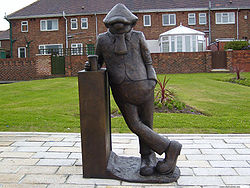
Picture - Statue of cartoon character Andy Capp, created by Hartlepool resident Reg Smythe and seen in The Daily Mirror and The Sunday Mirror newspapers since August 5, 1957
The modern town represents a joining together of "Old Hartlepool", locally known as the "Headland", and West Hartlepool. What was West Hartlepool became the larger town and both were formally unified in 1967. Today the term "West Hartlepool" is rarely heard outside the context of sport, but the town's only premier Rugby Union team still proudly retain the name (See Sports below)
The name of the town's professional football club reflected both boroughs; when it was formed in 1908, following the success of West Hartlepool in winning the FA Amateur Cup in 1905, it was called "Hartlepools United" in the hope of attracting support from both towns. When the boroughs combined in 1967 the club renamed itself "Hartlepool" before renaming itself Hartlepool United in the 1970s. Many fans of the club still refer to the team as "Pools".
The area became heavily industrialised with an ironworks (established 1838) and shipyards in the docks (established in the 1870s). By 1913, no fewer than 43 ship-owning companies were located in the town, with responsibility for 236 ships. This made it a key target for Germany in the First World War. One of the first German offensives against Britain was the Raid on Scarborough, Hartlepool and Whitby on the morning of 16 December 1914, when units of the Imperial German Navy bombarded Hartlepool, West Hartlepool, Whitby and Scarborough. Hartlepool was hit with a total of 1150 shells, killing 117 people.
Two coastal defence batteries at Hartlepool returned fire, firing 143 shells, damaging three German ships: SMS Seydlitz, SMS Moltke and SMS Blx¼cher. The Hartlepool engagement lasted roughly 50 minutes, and the coastal artillery defence was supported by the Royal Navy in the form of four destroyers, two light cruisers and a submarine, none of which had any significant impact on the German attackers. Private Theophilus Jones of the 18th Battalion Durham Light Infantry, who fell as a result of this bombardment, is sometimes described as the first military casualty on British soil since the English Civil War. This event (the death of the first soldiers on British soil) is commemorated by a 1921 memorial in Redheugh Gardens together with a plaque unveiled on the same day (seven years and one day after the East Coast Raid) at the spot on the Headland (the memorial by Philip Bennison illustrates four soldiers on one of four cartouches and the plaque, donated by a member of the public, refers to the 'first soldier' but gives no name). A living history group, the Hartlepool Military Heritage Memorial Society, portray men of that unit for educational and memorial purposes.
An attempt by the German High Command to repeat the attack a month later led to the Battle of Dogger Bank on 24 January 1915 at which the Blx¼cher was sunk. During World War II, RAF Greatham (also known as RAF West Hartlepool) was located on the current South British Steel Works.
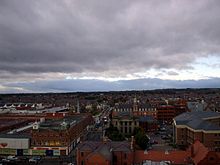
Picture - A view of the town facing west from the viewing platform built into the Christ Church tower.
Hartlepool suffered badly in the Great Depression of the 1930s and suffered high unemployment until the start of the Second World War, during which its shipbuilding and steel-making industries enjoyed a renaissance. Most of its output for the war effort were "Empire Ships". German bombers raided the town 43 times. After the war, both industries went into a severe decline. "Blanchland", the last ship to be constructed in Hartlepool, left the slips in 1961. In 1967 Betty James wrote how "if I had the luck to live anywhere in the North East [of England]...I would live near Hartlepool. If I had the luck". There was a boost to the retail sector in 1969 when Middleton Grange Shopping Centre was opened by Princess Anne, with over 130 new shops including Marks & Spencer and Woolworths.
Before the shopping centre was opened, the old town centre was located around Lynn Street, but most of the shops and the market had moved to a new shopping centre by 1974. Most of Lynn Street had by then been demolished to make way for a new housing estate. Only the north end of the street remains, now called Lynn Street North. This is where the Hartlepool Borough Council depot was based (alongside the Focus DIY store) until it moved to the marina in August 2006. In 1977 British Steel announced the closure of its Hartlepool steelworks with the loss of 1500 jobs. By the 1980s the area was affected by unemployment figures of over 30 per cent, the highest in the country. 630 jobs at British Steel were lost in 1983. A series of major investment projects in the 1990s revived the town centre with a new marina, rehabilitation of derelict land, the indoor conversion to modernise Middleton Grange Shopping Centre from the 1960s brutalist architecture, the Historic Quay regeneration, and the construction of much new housing.
Time Team visit Hartlepool
In March 2000, the Time Team archaeological investigation television programme located a lost Anglo-Saxon monastery in the grounds of St Hilda's Church.
Governance
Council
Hartlepool is divided into seventeen wards, each of which elect councillors who make up the borough council.
Members of Parliament
Hartlepool is represented in the House of Commons by one Member of Parliament. The current MP for the Hartlepool constituency is Iain Wright of the Labour Party. He was first elected in a by-election on 30 September 2004 with a much-reduced majority following an 18% swing to the Liberal Democrats. He retained the seat with a greatly increased majority in the 2005 general election, and was re-elected in the 2010 general election, which saw a substantial drop in the Liberal Democratic and smaller drop in the Labour votes, but left Wright with half-again the votes accorded the second-place (Tory) candidate.
Former Members of Parliament for Hartlepool since 1945 have been:
David Thomas Jones, Labour (1945-1959)
John Simon Kerans, Conservative (1959-1964)
Edward Leadbitter, Labour (1964-1992)
Peter Mandelson, Labour (1992-2004)
Mandelson resigned to take up a role in the European Commission. On 13 October 2008 he was created Baron Mandelson of Foy and Hartlepool following his appointment as Secretary of State for Business, Enterprise and Regulatory Reform in the British Government.
Emergency services
Hartlepool falls within the jurisdiction of Cleveland Police. Prior to 1974, it was under the jurisdiction of the Durham Constabulary.
Education
Hartlepool has six secondary schools: High Tunstall College of Science, Manor College of Technology, English Martyrs School and Sixth Form College, St Hilda's Church of England School, Brierton Community School and Dyke House Sports and Technology College. The town had planned to receive funding from central government to improve school buildings and facilities as a part of the Building Schools for the Future Programme, but this was cancelled because of the £7.5bn cuts programme.
Hartlepool College of Further Education is an educational establishment located in the centre of the town. The College has been established for well over a century in various forms, but the current campus was built in the 1960s. This building was set to be replaced with a new £62million custom-designed building; the new campus was approved in principle July 2008, and was set to be completed in 2011.
Hartlepool also has its own specialist sixth form college, Hartlepool Sixth Form College. A former grammar and comprehensive school, the college provides a number of AS and A2 Level courses for students across the town. A campus of Cleveland College of Art & Design, the only remaining specialist art and design college in the North East in either of the Further or Higher Education sectors, is in Hartlepool, alongside the Art Gallery in Church Square. Film director Ridley Scott was once a student there. The College has two further sites, both in nearby Middlesbrough.
Economy
Hartlepool's economy has historically been linked with the maritime industry, something which is still at the heart of local business. Within the greater docks development, Able UK are a leading maritime recycler, which in the Teesside Environmental Reclamation and Recycling Centre (TERRC), owns and operates the largest purpose-designed facility for recycling redundant marine structures. TERRC dismantled 13 former US Naval Ghost fleet vessels in 2003, and in February, 2009, decommissioned the French Navy aircraft carrier Clemenceau. Hartlepool's historic links to the maritime industry are centred around the Maritime Experience, and the supporting exhibits PS Wingfield Castle and HMS Trincomalee.
Camerons Brewery was founded in 1852. Following a series of take-overs, it came under the control of the Castle Eden Brewery in 2001 who merged the two breweries, closing down the Castle Eden plant. It brews a range of cask and bottled beers, including Strongarm, a 4% abv bitter, and Castle Eden Ale, a 4.2% bitter.
Hartlepool nuclear power station is an advanced gas-cooled reactor (AGR) type nuclear power plant opened near Hartlepool in the 1980s.
Middleton Grange Shopping Centre is the main shopping location. Aside from the local sports clubs, other local entertainment venues include a VUE Cinema, Mecca Bingo and UK Super Bowl.
Territorial Army
Situated in the New Armoury Centre, Easington Road are the following units.
Royal Marines Reserve
90 (North Riding) Signal Squadron
Transport
Road
Hartlepool is served by two primary routes which are the A179 road and the A689 road, both linking the town to the A19 road. The A179 road is the main road to the north west which leads to the A19 road, Durham and Tyneside. The A689 road is the main road to the south west towards the A19 & Billingham, Stockton, Middlesbrough and York. The A178 road leads south to Seaton Carew, Graythorpe, Seal Sands, Port Clarence and Middlesbrough via the Transporter bridge. The A1086 road leads north to Crimdon, Blackhall, Horden and Easington.
Rail
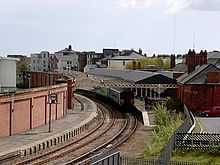
Picture - Hartlepool railway station
Hartlepool is served by Hartlepool railway station which is on the Durham Coast Line with hourly services to Newcastle and Middlesbrough which are provided by Northern Rail. There is a new service to London from Sunderland provided by Grand Central that uses Class 43 and Class 180 trains capable of 125 miles per hour (201 km/h). This is the first time in 15 years that Hartlepool has had a direct link to London by train. Seaton Carew railway station is also located on Seaton Lane
Bus
Local bus services are provided around the town mainly by Stagecoach.
The Stagecoach Group and Tees Valley travel operate services from Hartlepool to Billingham, Stockton and Middlesbrough. Other services are provided by Arriva and Go North East from Hartlepool to Peterlee, Durham, Dalton Park, Seaham, Hetton-le-Hole, Houghton-le-Spring, Sunderland, Gateshead and Newcastle.
Sea
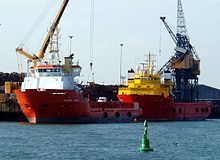
Picture - Offshore supply vessels in Hartlepool docks
Hartlepool has been a major seaport virtually since it was founded, and has throughout its entire history maintained a proud fishing heritage. During the industrial revolution massive new docks were created on the southern side of the channel running below the Headland, which gave rise to the town of West Hartlepool.
Now owned by PD Ports, the docks are still in use today and still capable of handling vessels of virtually all shapes and sizes. However, the capacity of the docks is now a fraction of what it once was, as after years of industrial downturn, a large portion of the former dockland was converted into a Superior Marina, capable of berthing 500 vessels. Hartlepool Marina is home to a wide variety of pleasure and working craft, with passage to and from the sea being determined by a lock, and visitors are always welcome to lay over and enjoy the hospitality of the town.
Hartlepool also has a permanent RNLI lifeboat station.
Climate
Hartlepool has an oceanic climate typical to the United Kingdom.
Sport
Football
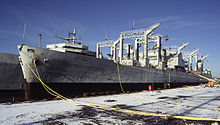
Picture - Former US Navy "Ghost ship" awaiting scrapping in Hartlepool
Hartlepool United is the town's professional football club and they play at Victoria Park, Hartlepool. They won promotion to League One for the 2007-08 season. Their first season back in League One, after a brief absence, they finished 15th. In December 2008, the club parted company with manager Danny Wilson. The club's most famous day, was back in 2005, just 8 minutes away from England's 2nd tier, Championship, when Chris Westwood gave away a penalty and Sheffield Wednesday pipped Hartlepool to a place in the Championship. The supporters of the club bear the nickname of Monkey Hangers. This is based upon a legend that during the Napoleonic wars a monkey which had been a ship's mascot was taken for a French spy and hanged.
Rugby Union
West Hartlepool R.F.C. are more commonly known as "West" and in the 2007 - 2008 season they won the North 2 East league title and were promoted to North 1 (which is the 5th tier of the national league structure). In the mid-1990s, West were the pride of North East rugby union (as were Newcastle Gosforth), and played in what is now the Guinness Premiership. West were then hit by bankruptcy and controversially sold their Brierton Lane stadium. There then followed a succession of relegations as professional players deserted the club, leaving West to pay off their debts which was a consequence of the clubs ambitious pursuit of professionalism.
Hartlepool Rovers are the 2nd best team in the town behind West with Hartlepool RFC coming in 3rd. Other clubs include, Hartlepool BBOB, Hartlepool Athletic & Seaton Carew.
West Hartlepool TDSOB (Tech) folded last year due to a high number of players leaving, the majority of which now play for either West or Rovers.
Tall Ships' Races
On 28 June 2006, Hartlepool celebrated after winning its bid to host The Tall Ships' Races. The town welcomed up to 125 tall ships in 2010, after being chosen by race organiser Sail Training International to be the finishing point for the race. Hartlepool greeted the ships, which sailed from Kristiansand in Norway on the second and final leg of the race.
Local media
Hartlepool Mail - local newspaper
BBC Tees - BBC local radio station
Radio Hartlepool - Community radio station serving the town
Monkeys
Hartlepool is famous for allegedly executing a monkey during the Napoleonic Wars. According to legend, fishermen from Hartlepool watched a French warship founder off the coast, and the only survivor was a monkey, which was dressed in French military uniform, presumably to amuse the officers on the ship. The unsophisticated fishermen assumed that this must be what Frenchmen looked like, and after a brief trial, summarily executed the monkey.
Although a popular story, it seems unlikely to be true. Historians have also pointed to the prior existence of a Scottish folk song called "And the Boddamers hung the Monkey-O". It describes how a monkey survived a shipwreck off the village of Boddam near Peterhead in Aberdeenshire. Because the villagers could only claim salvage rights if there were no survivors from the wreck, they allegedly hanged the monkey.
"Monkey hanger" and Chimp Choker are common terms of (semi-friendly) abuse aimed at "Poolies", often from bitter footballing rivals Darlington. The mascot of Hartlepool United F.C. is H'Angus the monkey. The man in the monkey costume, Stuart Drummond, stood for the post of Mayor in 2002 as H'angus the monkey, and campaigned on a platform which included free bananas for schoolchildren. To widespread surprise, he won, becoming the first directly-elected Mayor of Hartlepool, winning 7,400 votes with a 52% share of the vote and a turnout of 30%. He was re-elected by a landslide in 2005, winning 16,912 on a turnout of 51% - 10,000 votes more than his nearest rival, the Labour Party candidate.
The monkey legend is also linked with another of the town's sports clubs, Hartlepool Rovers RFC, which uses the hanging monkey as the club logo. On tours it would hang a monkey on the posts of the rugby pitch to spread the story.
Picture - The bone
In June 2005, a large bone was found washed ashore on Hartlepool beach by a local resident, which initially was taken as giving credence to the monkey legend. Analysis revealed the bone to be that of a red deer which had died 6,000 years ago. The bone is now in the collections of Hartlepool Museum Service.
In 2008, a novel based on the legend called The Hartlepool Monkey, written by Sean Longley, was published. The novel tells the story of the monkey, named Jacques LeSinge by the French doctor who discovers him, that was supposedly hanged. In the book, the monkey talks and possesses several other human characteristics.
Town twinning
Hx¼ckelhoven, Germany
Muskegon, Michigan
Sliema, Malta
People from Hartlepool
For a complete list, see Category:People from Hartlepool (district)
Betty James described how she "found more friendliness in Hartlepool than anywhere else in the North East [of England]".
More aircraft.
Source: WikiPedia